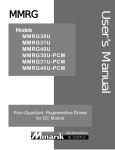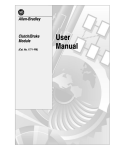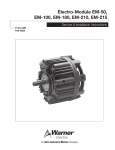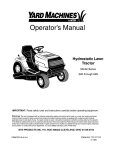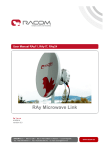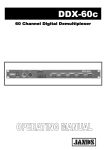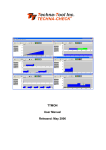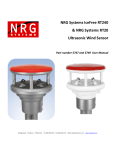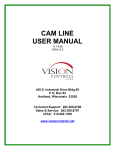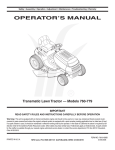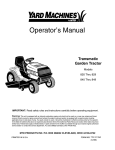Download impac 100 Operating & Installation Manual
Transcript
Operating & Installation Manual Variable Speed AC Motors 0 to 2 hp (1.5 kw) 115/230/460 VAC, 50/60 Hz Models: 711-3111 711-3211 & 711-3212 711-3231 & 711-3232 711-3431 & 711-3432 851-128 Rev. E Table of Contents 1.0 Safety Considerations . . . . . . . . . . . . . . . . . . . . . . . . . . . . . . . . . . . . . . . . 3 1.1 Grounding . . . . . . . . . . . . . . . . . . . . . . . . . . . . . . . . . . . . . . . . . . . 3 1.2 Fusing . . . . . . . . . . . . . . . . . . . . . . . . . . . . . . . . . . . . . . . . . . . . . . . 3 1.3 Power Wiring to Controller . . . . . . . . . . . . . . . . . . . . . . . . . . . . . 3 2.0 Introduction . . . . . . . . . . . . . . . . . . . . . . . . . . . . . . . . . . . . . . . . . . . . . . . . . 3 3.0 Product Description . . . . . . . . . . . . . . . . . . . . . . . . . . . . . . . . . . . . . . . . . . 3 4.0 Product Specifications . . . . . . . . . . . . . . . . . . . . . . . . . . . . . . . . . . . . . . . . 4 5.0 Conveyor Controller Installation . . . . . . . . . . . . . . . . . . . . . . . . . . . . . . . 5 5.1 Inspecting the Controller . . . . . . . . . . . . . . . . . . . . . . . . . . . . . . . 5 5.2 Mounting the Controller . . . . . . . . . . . . . . . . . . . . . . . . . . . . . . . . 5 5.3 Power Connections to Controller . . . . . . . . . . . . . . . . . . . . . . . . 6 5.4 Conveyor Controller Power-up Testing . . . . . . . . . . . . . . . . . . . 6 5.5 Motor Connections to Conveyor Controller . . . . . . . . . . . . . . . 6 5.6 Motor and Conveyor Controller Power-up Testing . . . . . . . . . 6 5.7 Internal Adjustments 5.8 851-128 Rev. E 1. General . . . . . . . . . . . . . . . . . . . . . . . . . . . . . . . . . . . . . . . 8 2 Acceleration Time (Parameter 30) . . . . . . . . . . . . . . . . 8 3. Deceleration Time (Parameter 31) . . . . . . . . . . . . . . . . 8 4. Minimum Frequency (Parameter 32) . . . . . . . . . . . . . . 9 5. Motor Overload Current (Parameter 42) . . . . . . . . . . . 9 6. Input Mode (Parameter 46) . . . . . . . . . . . . . . . . . . . . . . 9 5. Output Configure (Parameter 47) . . . . . . . . . . . . . . . . . 9 Controller Setup 1. Reversing . . . . . . . . . . . . . . . . . . . . . . . . . . . . . . . . . . . . . 9 2. Acceleration & Deceleration . . . . . . . . . . . . . . . . . . . . . . 9 5.9 Controlling the Speed with an External Reference Signal . . . 9 5.10 Controlling the Direction with an External Signal . . . . . . . . . . . 9 6.0 Implementing Conveyor Control Applications . . . . . . . . . . . . . . . . . . . 10 7.0 Operating the Conveyor Controller . . . . . . . . . . . . . . . . . . . . . . . . . . . . 11 7.1 Starting the Controller . . . . . . . . . . . . . . . . . . . . . . . . . . . . . . . . 11 7.2 Stopping the Controller . . . . . . . . . . . . . . . . . . . . . . . . . . . . . . . 11 8.0 Troubleshooting . . . . . . . . . . . . . . . . . . . . . . . . . . . . . . . . . . . . . . . . . . . . 12 9.0 Replacement Parts List . . . . . . . . . . . . . . . . . . . . . . . . . . . . . . . . . . . . . . 14 2 DMC-PD0597 impac 100 Operating & Installation Manual Variable Speed AC Motors, Three-Phase 1.0 Safety Considerations Ç This manual contains the information needed to install, operate, and troubleshoot the Dorner impac 100 Conveyor Controller. It is organized in a step-by-step fashion so that the Conveyor Controller may be safely set-up, in the shortest possible time. Ç Disconnect power at source before opening door of impac 100 Conveyor Controller. 1.1 3.0 Product Description Grounding Ç Ç The impac 100 Conveyor Controller is a low-cost Industrial Multi-Purpose Application Controller that can be used to control a Conveyor motor on/off operation as well as vary the speed of the motor. The Conveyor Controller is user-installable with control options that allow it to meet the needs of a wide range of Conveyor control applications (indexing, jogging, accumulation, variable speed, automatic end-stop, emergency-stop, clutchbrake, merging of Conveyors, linking multiple Conveyors, ...etc.). Ç The impac 100 Conveyor Controller’s motor control circuit is designed to support electrical interconnections to a variety of accessory kits (photo-eyes, E-stops, jog buttons, foot switches, E-stop pull cord units, process machine/PLC/PC dry contact interface, and more). Each kit includes brackets for mounting the unit to a Dorner 2100/3100/LPZ conveyor, cabling to wire the unit to an impac 100 Conveyor Controller, and instructions for mounting/wiring/operating the unit. The kits are connected to the impac 100 Conveyor Controller using convenient terminal point connections, inside the Controller. This allows the user to configure the kits to fit specific application needs and to re-configure the kits to perform new functions. Both control enclosure and motor must be securely mounted and properly grounded. Failure to properly ground either device may cause injury to personnel. 1.2 Fusing Ç If fuses need to be replaced, they must always conform to the values and ratings specified on the controls labels. 1.3 Power Wiring to Controller Ç Ç The branch circuit, which provides power to this control, must be protected. The circuit protection must be properly sized to meet the current requirements and must comply with all applicable codes. 2.0 Introduction Ç Ç The impac 100 Conveyor Controller comes with mounting hardware to allow mounting to a Dorner 2100, 3100 or LPZ Conveyor side rail (or Conveyor stand). The unit is housed in an NEMA 12/IP54 enclosure with Power “ON” and Motor “RUNNING” LED’s, a locking “ON/OFF” switch, a 24 volts D.C. power supply, adjustable motor overloads with manual reset, and pre-wired motor and AC line cords. Ç Ç Read this Manual completely and carefully. Pay special attention to the Warnings, Precautions, and Safety Rules listed. Failure to follow the instructions could produce Safety Hazards to personnel or lead to damage of the Conveyor Controller and/or the optional Accessory Kits. Due to the wide variety of setups & applications, guarding is the responsibility of the end user. DMC-PD0597 Overall Conveyor system reliability is enhanced by the impac 100 design features. Components meet applicable ANSI/NEC/IEC machine safety standards. Local on/off control and built-in motor & circuit overload protection enhance operator and application safety. Low voltage (24 volts D.C.) control circuits reduce installation and maintenance time as well as increase safety. A complete Conveyor Controller wiring schematic and troubleshooting guide are attached to the inside of the Conveyor Controller cover. 3 851-128 Rev. E impac 100 Operating & Installation Manual Variable Speed AC Motors, Three-Phase 4.0 Product Specifications impac 100 711-3111 711-3211 711-3212 Input Voltage 100 - 120 volts A.C. 1 Phase 50/60 Hz Input Line Fuse (1) 15 Ampere (3) 10 Ampere (3) 15 Ampere (3) 10 Ampere (3) 15 Ampere Input Current 10 Amperes 7 Amperes 10 Amperes 7 Amperes 10 Amperes 200 - 240 volts A.C. 1 Phase 50/60 Hz 711-3231 711-3232 200 - 240 volts A.C. 3 Phase 50/60 Hz Output Voltage 230 volts A.C., 3 Phase @ 60 Hz. Note: Models 711–3111, 711-3211 & 711-3212 have a single-phase input with a threephase output to the motor. Speed Reference Standard Speed Potentiometer mounted on cover of enclosure or Optional Isolated –10 to +10 volt analog input, 0 to +10 volt analog input, 4 to 20 milliampere input Motor Range in hp (watts) 0 to 1/2 (1 to 373) Operating Temperature A.C. Line Cord 0 to 3/4 (1 to 559) Above 3/4 to 1 (560 to 746) 0 to 1 (1 to 746) Above 1 to 2 (747 to 1500) 0 to 40° C to 95% Humidity (Non-condensing) 8 Ft (2.4 m) Pre-wired with NEMA 5-15P Plug 8 Ft (2.4 m) Pre-wired with NEMA 6-15P Plug 8 Ft (2.4 m) Pre-wired with NEMA 15-20 Plug Motor Cord 5 Ft (1.5 m) Pre-wired NEMA L15-20 Receptacle Enclosure NEMA Type 12 / IP54 Continuous Hinge, Weight: 23 lb (10.5 kg) Dimensions: 12″ (305 mm) High x 10″ (254 mm) Wide x 6″ (152 mm) Deep Internal Power Supply 24 volts D.C. @ 1.1 Amperes with Over-current and Short-circuit Protection Standard Features D Lockable Disconnect Switch D Line Fuses(s) D Angled Terminal Block for Easy Field Connections D 24 volt D.C. Power Supply Rated @ 1.1 Amperes for Field Devices D Power “ON” and Motor “RUNNING” Indicator Lights D Mounting Brackets and Hardware D Pre-wired Motor and AC Line Cords D Schematic Diagram Inside of Door D Four (4) 1/2″ NPT Knockouts with NEMA 12 Plugs D Speed Potentiometer Mounted on Enclosure Door D Reversing Switch Mounted on Enclosure Door NOTE: For additional information, refer to the following Dorner Publications: D impac 100 Catalog (Dorner Publication # 851-151) D impac 100 Accessory Kits Setup & Installation Guides (Dorner Publication # 851-108 through # 851-123) D impac 100 Application Guide (Dorner Publication # 851-124) 851-128 Rev. E 4 DMC-PD0597 impac 100 Operating & Installation Manual Variable Speed AC Motors, Three-Phase 5.0 Conveyor Controller Installation 5.1 a. For an Aluminum Support Stand Leg, refer to Figure 3 and detach, rotate and re-attach the Mounting Bars to the impac 100 enclosure in the horizontal position. Inspecting the Controller b. Select the desired mounting location and insert the two Single Drop-in T-bars into Leg channel by rolling each of them into position (see Figure 1). Carefully examine your Controller for shipping damage. Check to be certain that the controller you ordered is the one you received. Also check any optional accessory kits which you received. 5.2 c. Then, attach the impac 100 enclosure to the two Single Drop-in T-bars, using the M6 x 8 mm Button Head Cap Screws. Tighten Screws with a 4 mm Hex Key Wrench. Mounting the Controller 1 Select the desired location and mount the impac 100 enclosure to the conveyor T-slot channel (Figure 2) or an aluminum support stand leg (Figure 3) or steel support stand leg (Figure 4), using the hardware provided. 2 1 3 2 1 Figure 1: Drop-in T-bar Installation Detail Mounting in Conveyor T-slot 3 1 a. Insert the two Single Drop-in T-bars into conveyor T-slot by rolling each one into position (Figure 1). 1– M6 x 8 mm Button Head Cap Screws (6 each) 2– Mounting Bars (2 each) 3– Single Drop-in T-bars (2 each) b. Select the desired location and attach the impac 100 enclosure (in the same way it was packaged, when shipped) to the conveyor T-slot in the manner shown in Figure 2 using the two (2) M6 x 8 mm Button Head Cap Screws through the clearance hole in each Mounting Bar. Tighten the Screws with a 4 mm Hex Key Wrench. Figure 3: Aluminum Leg Attachment Detail Mounting to Steel Support Stand Leg a. For the Steel Support Stand Leg, refer to Figure 4 and detach, rotate and re-attach the Mounting Bars to the impac 100 enclosure in the horizontal position. b. Then, attach the impac 100 enclosure to the M6 Spring Nuts, using the M6 x 18 mm Button Head Cap Screws through the clearance hole in each Mounting Bar. Tighten the Screws with a 4 mm Hex Key Wrench. 2 1 2 1 3 4 3 3 4 1 1– M6 x 8 mm Button Head Cap Screws (2 each) 2– Single Drop-in T-bars (2 each) 3– Mounting Bars (2 each) 1– M6 x 8 mm Button Head Cap Screws (4 each) 2– Mounting Bars (2 each) 3– M6 x 18 mm Button Head Cap Screws (2 each) 4– M6 Spring Nuts (2 each) Figure 2: Conveyor T-slot Attachment Detail Figure 4: Steel Leg Attachment Detail Mounting to Aluminum Support Stand Leg DMC-PD0597 2 5 851-128 Rev. E impac 100 Operating & Installation Manual Variable Speed AC Motors, Three-Phase 5.3 Power Connections to Controller manual). Plug the controller into the appropriate power source and turn the controller disconnect switch ON. The Power “ON” indicator light, on the front on the controller, should illuminate. Move the FORWARD-STOP-REVERSE switch to “FORWARD”, the Motor “RUNNING” indicator light, on the front on the controller, should illuminate. Slowly advance the main speed potentiometer until you reach the desired speed. The motor should run and the conveyor belt will move. If the motor runs opposite of the direction expected, the motor leads on the terminals at the bottom the the Controller which are marked “T1” and “T2” will have to be reversed. Each Conveyor Controller has a pre-wired plug for power. The type of plug is dependent on the Controller voltage. Ç Ç Disconnect power, at power source, before opening the door of the impac 100 Conveyor Controller and attempting to make any electrical connections. Connections to the power source should always be the very last connections made. 5.4 Ç Disconnect power, at power source, before opening the door of the impac 100 Conveyor Controller and attempting to make any electrical connections. Connections to the power source should always be the very last connections made. Conveyor Controller Power-up Testing Test the Conveyor Controller before the motor is connected, and before any impac accessory kits are installed. Plug the Controller into the appropriate power source and turn the Controller disconnect switch ON. The Power “ON” and the Motor “RUNNING” indicator lights, on the front of the impac Conveyor Controller, should illuminate. 5.5 ÇÇ Once the power has been removed, open the impac Conveyor Controller door and reverse the armature leads at the terminals, at the bottom of the controller, labelled “T1” and “T2”. Motor Connections to Conveyor Controller Plug the motor cord into the impac 100 Conveyor Controller receptacle cord. Each Conveyor Controller has a pre-wired receptacle for a motor. The type of receptacle is dependent on the Controller voltage. If a motor was ordered along with the Controller, then the motor was pre-wired with a mating power plug. The motor can also be hard-wired to the Controller by first removing the receptacle and wiring directly to the terminals “T1”, “T2”, “T3” and “GND”, inside the Controller. See the Controller panel layout (Figure 5) and the schematic diagrams (Figures 6 & 7) for more information. 5.6 Motor and Conveyor Controller Power-up Testing Ç Ç When power is supplied to the impac 100 Conveyor Controller and the disconnect switch is turned “ON”, the Conveyor belt will begin to move. Figure 5: Sample 3-Phase Control Panel Layout (All Customer wiring is made to the Terminal Block located at the bottom of the Controller) After connections are made to the impac controller, move the main speed potentiometer, located on the front panel of the enclosure, to zero and the FORWARD-STOP-REVERSE switch to the “STOP” position (see picture on cover of this 851-128 Rev. E The VFD impac 100 is shipped with reversing switch disabled. 6 DMC-PD0597 impac 100 Operating & Installation Manual Variable Speed AC Motors, Three-Phase Figure 6: Schematic Diagram for impac 100 Controller Models 711-3211 & 711-3212 Models 711-3231 & 711-3232 DMC-PD0597 7 851-128 Rev. E impac 100 Operating & Installation Manual Variable Speed AC Motors, Three-Phase DISC FU1 L1 L1 15A ORANGE 115V T1 U RED RED BLK 115VAC 1PHASE 60Hz V L2 PINK L2 PINK N T2 GREY T3 W WHT BRN 230V BRN 10K 2 WHT PINK BLACK ORG 7 SP200 9 VFD R 9 GREY 5 5 F 9 PINK 5 4 YELLOW GREEN 2 12 3 AC1 MR AC2 24VDC WHITE 11 13 14 (–) (+) 24V COM LT BLUE COM MOTOR RUNNING 9 5 G BLK LT BLUE MR DK BLUE 24V POWER ON Y F FWD PINK TAN 14 13 OFF R REV GREY ORG 14 13 VIOLET BLK MR 12 COM COM 24V 24V PE1 PE2 ES1 ES2 RR1 RR2 FW1 FW2 RV1 RV2 MR1 BRN 8 MR2 SP1 SP2 PHOTOEYE EYE V1 PE1 V2 PE2 REMOTE RUN PUSH–BUTTON ES1 ES2 REMOTE RUN CONTACT RR1 FORWARD CONTROL RR2 REVERSE CONTROL MOTOR RUNNING CONTACT MR1 INPUT SIGNALS SPARE TERMINALS MR2 OUTPUT SIGNAL Figure 7: Schematic Diagram for impac 100 Controller Models 711-3111 5.7 Internal Drive Adjustments 2. Acceleration Time Allen-Bradley parameter 30/Reliance parameter 30: This is the time it takes for the motor to ramp up to full speed from a stop. This parameter has been set to 1 second, the factory default value is 5 or 10 seconds. 3. Deceleration Time Allen-Bradley parameter 31/Reliance parameter 31: This is the time it takes for the motor to ramp down from full speed to a stop. This parameter has been set to 1 second, the factory default value is 5 or 10 seconds. If this value is set too short, the drive may fault. 1. General All of the drive parameters are set to the drive manufacturers default values except for the parameters listed below. These variable frequency drive operating parameters are set to typical conveyor user values. A complete list of drive parameters can be found in the drive manufacturers users manual that shipped with the impac 100. The 711-3111 uses a Reliance drive. All other impac models use Allen-Bradley. 851-128 Rev. E 8 DMC-PD0597 impac 100 Operating & Installation Manual Variable Speed AC Motors, Three-Phase 4. Minimum Frequency ÇÇ Allen-Bradley parameter 32/Reliance parameter 00: This is the lowest frequency (speed) that the drive will output. This parameter is set for 6Hz. This is 10% of full speed. The factory default value is 0 Hz. 5. Motor Overload Current Allen-Bradley parameter 42/Reliance parameter 02: This parameter has been set to the FLA (full load ampere) rating of the motor that was ordered with the impac. If no motor was ordered then the parameter is set to a value based on approximately 1/2 of the rating of the impac 100 ordered. The impac 100 control is shipped with the speed pot on the front of the control as the only method to very the speed of the motor. Some applications may require that the speed of the motor be controlled by another machine or controller. A 0 to 10 Volt isolated speed signal may be used to control the speed of the motor in place of the speed potentiometer on the front of the controller. A shielded cable is recommended for the external speed reference signal. The shield should be grounded at the signal source end only. To connect an external speed reference: D Locate the terminal block near the face of the AC drive. D Remove the brown wire from the terminal labeled “1”. D Tape the end of the exposed wire to avoid shorting to adjacent devices. D Remove the white wire from the terminal labeled “2”. D Tape the end of the exposed wire to avoid shorting to adjacent devices. D Remove the orange wire from the terminal labeled “3”. D Tape the end of the exposed wire to avoid shorting to adjacent devices. D Connect the external signal V+ to the terminal labeled “2”. D Connect the external signal V– to the terminal labeled “3”. 6. Input Mode/Start Control Allen-Bradley parameter 46/Reliance parameter 10: This parameter has been set to 1 for Allen-Bradley and 2 for Reliance. This defines how the input wiring is configured. DO NOT CHANGE THIS PARAMETER otherwise the forward/stop/reverse switch on the door of the impac and/or any installed kits will not control the drive. 7. Output Configure Allen-Bradley parameter 47/Reliance parameter 12: This parameter has been set to 2. This parameter controls the motor running contact (terminals MR1 and MR2) and the motor “RUNNING” indicator light. 5.8 Controller Setup 1. Reversing The VFD impac 100 is shipped with the reversing switch disabled. Damage may occur to the belt of a center drive conveyor if operated in the reverse direction. If a Center Drive is not being used, reversing can be enabled as follows: The speed pot on the door of the impac controller is now disabled. 5.10 Controlling the Direction with an External Signal a. Open the cover of the impac 100. Locate the terminal blocks labeled “RV1” and “RV2”. Remove one of the wires from terminal “RV1” and re-connect it at terminal “RV2”. The impac 100 control is shipped with the FWD-OFF-REVERSE switch, located on the front of the enclosure, as the only method to change the direction of the motor. Some applications may require that the direction of the motor be controlled by another machine or controller. To control the direction from a remote location: D Remove the blue jumper wires from between the terminals labeled “FW1” & “FW2”, and “RV1” & “RV2”. This will disable the selector switch on the front of the enclosure. D Supply a dry contact between terminals “RR2” & “FW2”. Closing this contact will command the “Forward” direction. D Supply a dry contact between terminals “RR2” & “RV2”. Closing this contact will command the “Reverse” direction. b. To disable reversing, remove the jumper at terminal “RV2” and reconnect it to terminal “RV1”. 2. Acceleration & Deceleration The Variable Frequency Drive (VFD) has an adjustable value for the acceleration and deceleration. The range is 0.1 to 600 Seconds. If this time value is set too short the drive will fault. To change the acceleration, change drive parameter #30 to the desired time. To change the deceleration, change drive parameter #31 to the desired time. Refer to the drive manufacturer’s user manual for parameter programming instructions and for details on an optional braking resistor that can be added for applications that require an extremely short deceleration time. 5.9 NOTE: Close only one direction at a time. If both “Forward” and “Reverse” is commanded at the same time, an undetermined direction can occur. Controlling the Speed with an External Reference Signal DMC-PD0597 Ç Any external signal or equipment connected to the control must be electronically (e.g., optically) isolated. Using signals which are not isolated can damage the drive control board and/or any external equipment. 9 851-128 Rev. E impac 100 Operating & Installation Manual Variable Speed AC Motors, Three-Phase Figure 8: Simplified impac 100 Control Circuit 6.0 Implementing Conveyor Control Applications then run the conveyor. Accessories connected in parallel are connected to the same impac 100 terminal points. For example, if two accessory kits are wired to PE1-PE2 then when either kit is “on” the conveyor will run. Any number of impac accessories can be configured in any of the above series and parallel combinations. The impac 100 control circuit is designed to support electrical interconnections to a variety of accessory kits (photo-eyes, E-stops, jog buttons, foot switches, E-stop pull cord units, process machine/PLC/PC dry contact interface, and more). The kits are connected to the impac 100 using convenient terminal point connections inside the controller. This allows the user to interconnect the kits to fit specific application control needs. 3. The third group of terminals (MR1-MR2) provide an output contact (dry contact) that is closed when the conveyor is running. This can be used to link multiple conveyor operations together or to provide status back to a host controller. A simplified version of the impac 100 control circuit is shown in Figure 8. Four groupings of terminal point connections have been provided for connecting all impac accessory kits. 4. The last group of terminals (SP1-SP2) are two spare terminal points that the user can use for extra termination points for accessory kit wiring. 1. The first group (COM-24V) provides 24 volts D.C. power for any accessory kits that need power (photo-eyes, illuminated pushbuttons, etc.). To select, configure, and implement a conveyor control application using the impac 100 Conveyor Controller and impac Accessory Kits the user should use the following steps. 1. Remove power to the impac Conveyor Controller. 2. The next group (PE1-PE2, ES1-ES2, and RR1-RR2) provide three sets of control points for wiring accessory kits into the impac 100 control circuit. Each group is configured with a jumper when the impac 100 controller is shipped. When an accessory kit is to be installed the jumper is removed and the kit connected. Each set of control points represents a “series” connection to the impac 100 control circuit. When accessory kits are wired in “series” it means that all connected accessories must be “on” for the conveyor to run. For example, if an accessory kit is wired to PE1-PE2 and another accessory kit is wired to ES1-ES2, then both accessories must be “on” for the conveyor to run. Before installing and wiring any accessory kits, Remove power to the impac controller by unplugging the impac controller from the power source. 2. Select Desired Control Application from the Dorner impac 100 Application Guide. Included with the impac 100 Application Guide are a list of conveyor control application examples that detail the following for many different conveyor control applications: D A description of the conveyor application control requirements D An illustration of the conveyor with the impac 100 controller and impac accessory kits mounted The impac 100 controller also supports wiring impac accessory kits in “parallel”. When an accessory kit is wired in “parallel” it means “if either” accessory kit is “on” 851-128 Rev. E D A list of hardware required to implement the control application described 10 DMC-PD0597 impac 100 Operating & Installation Manual Variable Speed AC Motors, Three-Phase D A description of the conveyor operation 4. Connect the impac accessory kits to the impac 100 Conveyor Controller D Detailed conveyor control setup instructions From the selected Application Example in the Dorner impac 100 Application Guide Connect the impac accessory kit cables to the impac controller terminal block as detailed in the application “Setup” description. D Illustration that shows how all accessory devices are connected to the impac 100 controller Based on review of the Dorner impac 100 Application Guide select the application example that meets the needs of the end-user application. If required, make any final adjustments to the application accessory kit control connections needed by your particular application. 5. Verify proper conveyor operation Test and operate the application based on the information detailed in the selected application “Operation & Test” description. 3. Install all required impac accessory kits 6. File copy of the Control Application Documentation Place a copy of the Conveyor Control Application Example, that was used in step 4, inside impac 100 controller. Install all accessory kits required for the application. The selected Application Example in the Dorner impac 100 Application Guide will show the general area of were the kits are to be located on the conveyor. Follow the impac Accessory kit Setup & Installation Guide for mounting and cable routing details. Ç 7.0 Operating the Conveyor Controller 7.1 Ç The conveyor will be “ready to run” when the impac ON/OFF disconnect switch is turned ON. The Power “ON” light will be illuminated whenever power is applied to the Conveyor Controller and the ON/OFF disconnect switch is turned ON. If there are no impac accessory kits installed, the conveyor will run. If there is(are) any installed accessory kit(s), the conveyor may run, depending on the “ON/OFF” state of the accessory kits. When an accessory kit or kits allow the conveyor to run, the Motor “RUNNING” light will be ON and the motor will run. Disconnect power, at power source, before opening the door of the impac 100 Conveyor Controller and attempting to make any electrical connections. Connections to the power source should always be the very last connections made. Each impac accessory kit includes: Setup & Installation Guide; brackets for mounting; cabling to wire the unit to an impac 100 controller; and instructions for mounting/wiring/operating the unit. There are two 1/2″ NPT knockouts available for accessory kit installation at the bottom on the controller. Remove the rubber seal, and install the accessory kit cable using the cord grip provided with the kit. The only wiring that is required will be at the accessory terminal block inside the controller. A 1/8″ (3 mm) flat blade screwdriver is shipped with the controller for wiring to the terminal block. DMC-PD0597 Starting the Controller 7.2 Stopping the Controller The conveyor will be stopped when the impac ON/OFF disconnect switch is turned OFF. The Power “ON” light will be OFF whenever power is removed from the Conveyor Controller or the ON/OFF disconnect switch is turned OFF. If there are installed accessory kit(s), the conveyor may stop running, depending on the state of the accessory kits. When an accessory kit prohibits the conveyor from running, the Motor “RUNNING” light will turn OFF and the motor will stop. 11 851-128 Rev. E impac 100 Operating & Installation Manual Variable Speed AC Motors, Three-Phase 8.0 Troubleshooting (Refer to Figures 5, 6 & 7, for component locations) PROBLEM CAUSE CORRECTION Motor will not run and Motor “RUNNING” indicator is ON and “POWER” indicator is illuminated. Open wiring connection between impac 100 & motor. Remove any power and, using appropriate means, check continuity and integrity of wiring. Motor Cord is not connected to motor Properly connect motor cord. Defective motor Replace motor. *AC variable frequency drive has faulted. Cycle power to the impac 100 to reset drive. One or more accessory kits are not working properly and thus causing an OPEN contact. Check and properly install and wire accessory kits per the Setup & Installation Guide information provided with kit. One or more accessory kit jumpers, at impac 100 are removed and kit Devices are not installed, or incorrectly installed. Properly install and wire accessory kits per the Setup & Installation Guide information provided with kit. Power supply fuse has blown. Replace with correct amperage and type of fuse. One or more accessory kits are incorrectly installed and thus shutting-down the power supply. Properly install and wire accessory kits per the Setup & Installation Guide information provided with kit. No power to impac 100 or impac 100 is not plugged-in. Check all related wiring and make sure impac 100 power cord is plugged-in. Blown line fuse FU1 and/or FU2 and/or FU3. Replace with correct amperage and type of fuse and/or fuses. One or more accessory kits are incorrectly installed. Properly install and wire accessory kits per the Setup & Installation Guide information provided with kit. One or more accessory kit jumpers, at impac 100, is/are not correctly installed. Properly install and wire appropriate jumpers per the Setup & Installation Guide information provided with kit. Motor will not run and Motor “RUNNING” indicator is OFF, “POWER” indicator is illuminated and Power Supply LED is ON. Motor will not run and Motor “RUNNING” indicator is OFF, “POWER” indicator is illuminated and Power Supply LED is OFF. Motor will not run and Motor “RUNNING” indicator is OFF and “POWER” indicator is not illuminated. Motor runs unexpectedly and Motor “RUNNING” indicator is ON and “POWER” indicator is illuminated. 851-128 Rev. E 12 DMC-PD0597 impac 100 Operating & Installation Manual Variable Speed AC Motors, Three-Phase PROBLEM Motor speed will not increase when SPEED Potentiometer is increased. Motor will not switch between FORWARD and REVERSE. Motor “RUNNING” contact does not give indication. CAUSE CORRECTION Wiring connections are loose. Securely anchor all connections. “FORWARD-STOP-REVERSE” switch is not in the STOP position. Move switch to STOP position. AC drive is defective. Replace drive. SPEED potentiometer is shorted or defective. Locate circuit short or replace potentiometer. Wiring connections are loose. Securely anchor all connections. “FORWARD-STOP-REVERSE” switch (S2) is defective. Replace defective “FORWARDSTOP-REVERSE” switch. Relay (F) or relay (R) defective. Replace defective Relay(s). Relay (F) or relay (R) not properly seated in mounting socket(s). Securely and properly seat Relay(s) in their respective socket(s). “REVERSE” Enable Jumper is in the REVERSE DISABLE position. Move Jumper position. Wiring connections are loose. Securely anchor all connections. Relay (MR) is defective. Replace defective Relay. “FORWARD-STOP-REVERSE” (S2) switch is in STOP position. Move switch away from STOP position. *AC variable frequency drive has faulted. Cycle power to the impac 100 to reset drive. to ENABLE * Refer to the drive manufacturer’s user manual “Troubleshooting and Fault Information” section (chapter 6) for additional information. DMC-PD0597 13 851-128 Rev. E impac 100 Operating & Installation Manual Variable Speed AC Motors, Three-Phase 9.0 Replacement Parts List Item Description 1 Power Supply 2 AC Drive 3 4 5 AC Drive Keypad Fuse Holder Fuse Dorner Part Number 831–110 Model 711–3211, Model 711–3231 805–869 Model 711–3212, Model 711–3232 805–885 Model 711–3431 805–886 Model 711–3432 805–887 Model 711–3111 805–997 All models except 711–3111 805–985 Model 711–3111 805–998 All models except 711–3111 819–132 Model 711–3111 819–134 Model 711-3431 819–138 Model 711-3211, Model 711-3231 Model 711-3432 819–113 Model 711-3212, Model 711-3232, Model 711–3111 819–103 6 Relay 805–470 7 Disconnect Switch 805–881 8 Amber Pilot Light Assembly 830–133 9 Green Pilot Light Assembly 830–134 10 Forward - Stop - Reverse Switch 830–161 11 Speed Potentiometer 805–866 851-128 Rev. E 14 DMC-PD0597 impac 100 Operating & Installation Manual Variable Speed AC Motors, Three-Phase Notes DMC-PD0597 15 851-128 Rev. E Return Policy Returns must have prior written factory authorization or they will not be accepted. Items that are returned to Dorner without authorization will not be credited nor returned to the original sender. When calling for authorization, please have the following information ready for the Dorner factory representative or your local distributor: 1. Name and address of customer. 2. Dorner part number(s) of Item(s) being returned. 3. Reason for return. 4. Customer’s original order number used when ordering the item(s). 5. Dorner or distributor invoice number. A representative will discuss action to be taken on the returned items and provide a Returned Goods Authorization number for reference. There will be a return charge on all new undamaged items returned for credit where Dorner was not at fault. Dorner is not responsible for return freight on such items. Conveyors and conveyor accessories Standard catalog conveyors 30% MPB Series, cleated and specialty belt conveyors 50% 7400 & 7600 Series conveyors non–returnable items Engineered special products case by case Drives and accessories 30% Sanitary stand supports non–returnable items Parts Standard stock parts MPB, cleated and specialty belts 30% non–returnable items Returns will not be accepted after 60 days from original invoice date. The return charge covers inspection, cleaning, disassembly, disposal and reissuing of components to inventory. If a replacement is needed prior to evaluation of returned item, a purchase order must be issued. Credit (if any) is issued only after return and evaluation is complete. Dorner has representatives throughout the world. Contact Dorner for the name of your local representative. Our Technical Sales, Catalog Sales and Service Teams will gladly help with your questions on Dorner products. For a copy of Dorner’s Warranty, contact factory, distributor, service center or visit our website at www.dorner.com. Dorner Mfg. Corp. reserves the right to change or discontinue products without notice. All products and services are covered in accordance with our standard warranty. All rights reserved. Dorner Mfg. Corp. 1997 851-128 Rev. E DORNER MFG. CORP. DORNER 975 Cottonwood Ave., PO Box 20 Hartland, WI 53029-0020 USA Arnold-Sommerfeld-Ring 2 D-52499 Baesweiler USA TEL 1-800-397-8664 (USA) FAX 1-800-369-2440 (USA) Germany TEL (02401) 80 52 90 FAX (02401) 80 52 93 Outside the USA: TEL 1-414-367-7600, FAX 1-414-367-5827 Printed in U.S.A. DMC-PD0597
















